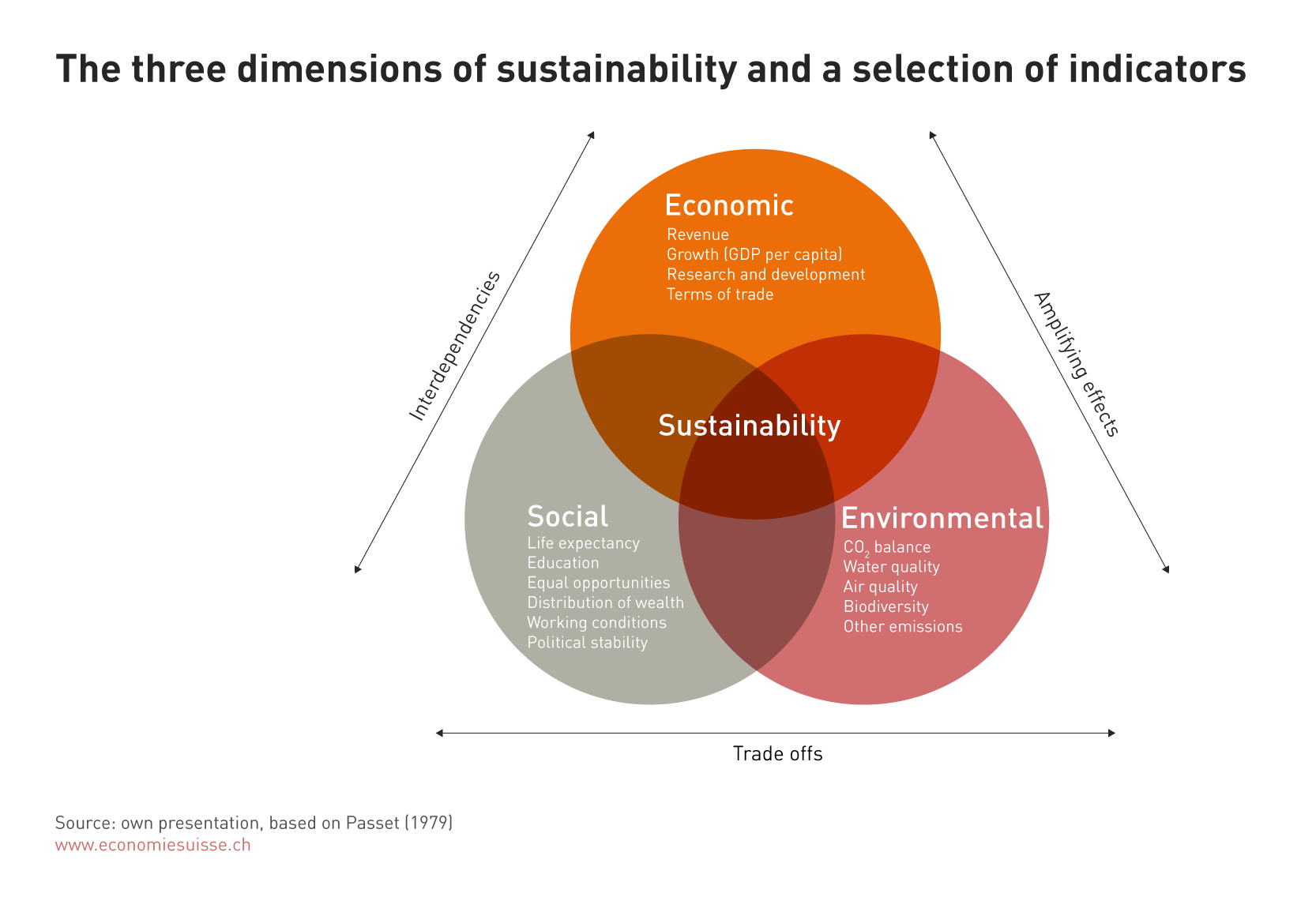Why trade supports rather than hinders sustainable development
- Introduction Executive summary | Positions of economiesuisse
- Chapter 1 Sustainable development includes several dimensions
- Chapter 2 International trade is a prerequisite for sustainable development
- Chapter 3 How Swiss business contributes to sustainable development
- Chapter 4 Effective instruments in the field of sustainability from a Swiss perspective
Sustainable development includes several dimensions
Sustainable development is one of the greatest challenges our society is facing. According to the UN World Commission on Environment and Development, “sustainable development is development that meets the needs of the present without compromising the ability of future generations to meet their own needs”. In order to achieve globally sustainable development, the UN member states jointly defined 17 Sustainable Development Goals (SDGs) for the period up to 2030. The central elements include, for example, the promotion of inclusive and sustainable economic growth, the protection of human rights and the conservation of the planet’s natural resources. The UN member states agree that these challenges and commitments are interlinked and require integrated solutions. It is therefore necessary to take a holistic view of the SDG Agenda 2030 and to purposely intervene where the greatest impact can be achieved.
Sustainability includes environmental, economic and social aspects
The SDGs also illustrate that sustainable development includes not only a consideration of environmental aspects, but social and economic dimensions as well.

These three dimensions are closely interlinked and mutually dependent. If, for example, one factor affects a particular dimension, sooner or later this may have positive or negative consequences for the other dimensions. These are measured by indicators. However, such measurement methods are the subject of heated discussions, as certain aspects are difficult to quantify. It is not possible to make a clear distinction between the three dimensions because they overlap to some extent and have common points of intersection. The interdependencies within the sustainability triangle can be illustrated using the following example.
If a multinational company creates new jobs in a developing or emerging country, it increases the material standard of living and purchasing power locally (economic dimension) by means of knowledge and technology transfers. This enables the local population to gain better access to education and health (social dimension). As income rises, consumption also increases, which is desirable from a social and economic perspective. In the short to medium term, more consumption and more production can indeed lead to an increase in CO2 emission. In the longer term, however, higher incomes allow the local population to invest in more environmentally sustainable goods, such as more efficient air conditioning systems. In addition, the introduction of new technologies by foreign companies often helps to make local production more resource-efficient (environmental dimension).
Beware of incomplete sustainability analyses (example of Borneo)
As mentioned above, complex challenges must be considered in a holistic way (as holistically as possible). This includes sustainable development. It is not enough to focus on just one dimension. Otherwise, new problems may arise unintentionally, as the use of dichlorodiphenyltrichloroethane (DDT) on the island of Borneo in the 1950s shows. With the insecticide DDT it was possible to kill mosquitoes and thus stop the spread of malaria on the island. However, it also led to the collapse of rows of cottage roofs on Borneo and to a shortage of food for the population. DDT not only destroyed malaria-carrying mosquitoes, but also wasps, which nourished their offspring with caterpillars. Without the wasps, the spread of the caterpillars increased exponentially. As a result, the caterpillars were able to invade and destroy the roofs of the local population’s cottages. In addition, many cats died from the use of DDT, much to the delight of the rodents on the island. Thus, they were able to devour the grain supplies of the local population undisturbed. The example of Borneo shows how a well-intentioned measure to strengthen the social dimension (better health by controlling malaria) led to a change in the environmental dimension (fewer wasps and cats, more caterpillars and rodents) and ultimately to a weakening of the economic dimension (fewer supplies, damage to property).
Business depends on sustainable development
The business community has a strong self-interest in sustainable development. Only a sustainable and careful use of the production factors labour, soil and capital can ensure the economic capacity to act in the long term. Sustainability is therefore the basis of entrepreneurial action, as this is the only way to guarantee economic success in the long term. For this reason, far-sighted companies strive not only for a high short-term return on investment. They also have a fundamental interest in satisfied, healthy and well-trained employees. Such employees tend to be more productive and more willing to stay with the company. Furthermore, companies are dependent on an intact environment that will continue to provide relevant natural resources in the future. In addition, entrepreneurial solutions play a decisive role in overcoming environmental and social challenges.





